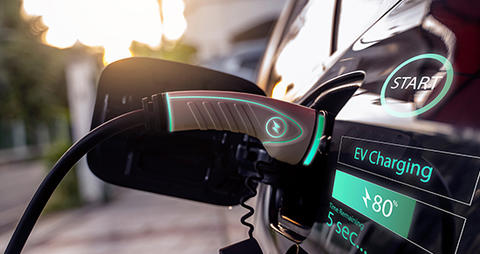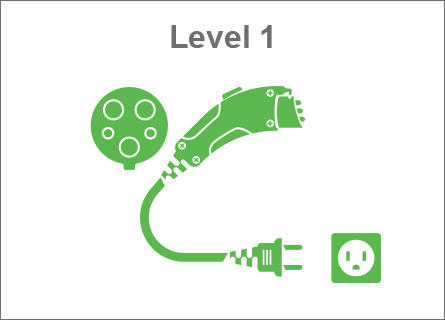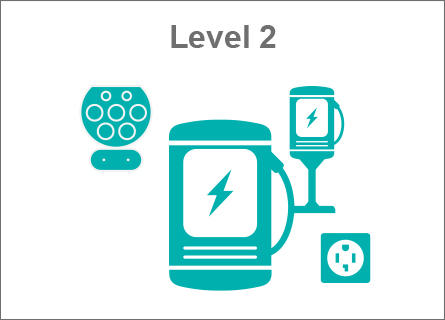Electric Vehicle Charging
Whether you’re at home or on the road, you have easy and convenient options to charge your electric vehicle.


Level 1 Charger (120 volt)
- Charges EV with a standard 120-volt wall outlet
- No installation necessary
- Provides up to five miles of range for each hour that EV is charged
- Slowest, least expensive way to charge an EV
- With overnight charging, can replenish a standard San Diego commute of 25 miles or more

Level 2 Charger (240 volt)
- Charges EV with a 240-volt wall outlet on a dedicated circuit
- Requires installation by a certified electrician
- Provides up to 26 miles of range for each hour that EV is charged
- Quicker charging time than a Level 1
- Can be installed at personal residences or found at public charging stations

DC Fast Charger (480 volt)
- Charges EV with a 480-volt outlet
- Found only at public charging stations
- Quickest charging time
- Provides about 50 miles for every 15 minutes that EV is charged
EV Charging Locations
Electric Vehicle Charging at Home
At-home EV charging accounts for more than 80% of current EV charging. To experience the convenience of at-home EV charging, plug your EV into a standard Level 1 (120-volt) electrical outlet or install a Level 2 (240-volt) charging station.
Electric Vehicle Charging on the Go
With thousands of public charging stations in the San Diego area, you can grab a charge while you’re on the road. In fact, SDG&E has installed Level 2 and DC Fast chargers at parks, beaches, Park & Rides and school campuses across the region.
Many public chargers are free or offer reduced, pay-as-you use fees. Also, many EVs have built-in apps to help you locate the closest charging station. Some manufacturers even provide new EV customers with free charging for a period at select public charging stations.
Find a public charging station near you!
If you are enrolled in an EV pricing plan and charge your EV at home, you can expect lower electricity rates in the morning, early afternoon and overnight. Electricity prices vary by time of day, day of the week and season. Some EVs and specialized charging stations can be programmed to start and stop charging automatically at times when electricity prices are lower.
Visit our EV Pricing Plans page to search plan options.
An EV’s charging time is based on the type and capabilities of your EV, the speed of your charging equipment and how far you drive between charges.
For example, if you commute about 40-50 miles per day, you may be able to fully charge your EV overnight using a Level 1, 120-volt charger. If you install a Level 2, 240-volt charging station in your home, you could charge your EV up to five times faster than a Level 1.
If you opt to charge your EV using a DC Fast Charger at a public station, your EV will charge the fastest: approximately 100-200 miles of range per 30 minutes of charging.
Level 1 and 2 chargers have a uniform plug standard. Meanwhile, DC fast chargers have three types of connectors: CHAdeMO, CCS and Tesla. (CCS is increasingly becoming the industry standard for DC fast chargers.)
If you live in a multi-unit residence, you may need approval from your homeowners association (HOA) to install charging equipment or charge your vehicle in common areas.
Otherwise, you can charge your EV from one of thousands of public charging stations — including those at workplaces, schools, parks and beaches — that are available throughout the greater San Diego area. Over the next several years, SDG&E will also be working directly with property managers across our service territory to install more charging stations at apartment complexes.
Refer to your EV’s manufacturer for information specific to your EV, EV battery and prolonging the battery life. In general, here are some ways that may prolong your EV’s battery health:
- Avoid over or undercharging — EVs are installed with battery management systems that help them avoid being charged or discharged at extreme states. Ideally, you want to keep your charge between 20-80% and only charge it fully for long-distance trips.
- Avoid hot temperatures — While EV batteries have a built-in temperature control system, minimize your EV’s exposure to extreme heat while your car is parked. On hot days, park your EV in a garage or shaded location.
- Limit fast charging — Fast chargers quickly deliver a high amount of electric current into your EV battery, which may degrade your EV battery over time. Use fast chargers in moderation and a Level 1 or 2 charger when possible.
Want Your Own EV Charger?
Check out our helpful resources to plan for and install a charger at home.



